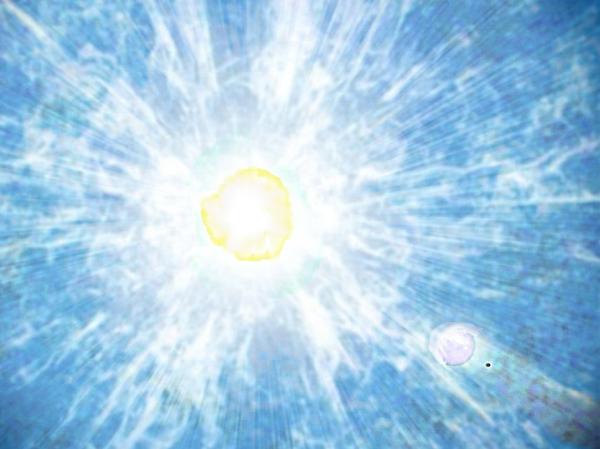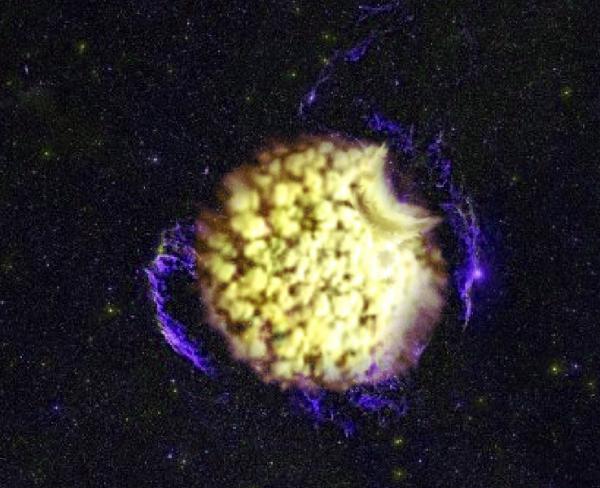BY LETTER
Regor Supernova, The
History > 3200 to 5200 AT: Inner Sphere Era > 3800 to 4450 AT: The Second Federation
Galactography > Regions of Space > Middle Regions/Hinter-regions
Galactography > Civilized Galaxy - Sephirotic Empires > Non-Coercive Zone (NoCoZo)
History > Significant Historical Events
Galactography > Regions of Space > Middle Regions/Hinter-regions
Galactography > Civilized Galaxy - Sephirotic Empires > Non-Coercive Zone (NoCoZo)
History > Significant Historical Events
A survey mission to this star arrived too late to prevent a supernova | |
 Image from Steve Bowers | |
| Emissions from the exploding Wolf-Rayet star blast the surrounding nebula and the other stars in this system | |
Star: Regor Aa
Type: former Wolf-Rayet star, now magnetar
Distance from Sol: 1221 ly
Companions: Regor Ab, O-type star, 1.2 AU separation
Regor B, B-type star, 15,000 AU separation
Regor C,D,E, assorted dwarfs 20,000+ AU separation
Regor (Gamma-2 Velorum) was for many millennia a closely observed object. This star was named after an Atomic Age space pioneer, Roger Chaffee, who died in an early Moon-rocket fire. The brightest component of the six stars in this system, a brilliant Wolf-Rayet star 100,000 times as luminous as Sol (mostly in UV), was expected to collapse and undergo a supernova explosion, although the exact timing of this event was not well known. During the Age of Establishment the emerging NoCoZo expanded its territory towards this star, and the apparently imminent explosion began to affect markets adversely; especially in the Vela sector.
A transapient cosmic engineering concern, Vaneld Stellar Engineering AG, sent off a small fleet from Argelander in 2870 towards Regor, a distance of 970 light years. Using the new Displacement Drive this trip could be accomplished at 0.6c, more than half the speed of light. The Vaneld AG starships would arrive in 4486 AT. In fact the ship was upgraded during the flight using information sent from Argelander, and arrived in 4082 AT. To cut down on cost they did not take a wormhole linelayer with them, hoping to bring one in later when the star was stabilised.
During the flight the star was observed closely, and these observations were compared with data from more distant supernovae with similar characteristics. The hot Wolf-Rayet star, with a temperature of 70,000 K, had expelled almost all of its outer hydrogen/helium shell, having lost 30 solar masses of matter through a phenomenal stellar wind, and formed a vast diffuse cloud a light year across. The remnant, now containing only 10 solar masses was fusing carbon in its core, and soon this would progress to fusing neon, oxygen and silicon. In the final stages the star would start to fuse iron, then quickly collapse.
The Starlifting Effort
Vaneld AG had hoped to have time to extract some of the outer shell of carbon from the star, using the vast amounts of energy emitted to lift the matter out of the gravity well. This would have slowed down the eventual collapse of the star, and hopefully (as already achieved at Betelgeuse) this would postpone the explosion for many millennia. However the star was too far gone for this to be effective, and when the star-lifting fleet arrived there was less than a hundred years before the star was likely to detonate.Although the Vaneld starlifters attempted to place a huff-and-puff mass removal system in place, the strong stellar wind and radiation made working conditions almost impossible, with interactions between the Wolf-Rayet star and the nearby secondary star (itself a hot class B supergiant, only one astronomic unit away) producing a high level of X-rays.
Even after the system was constructed it was found to be inadequate to delay the supernova by more than a few years. The star was too large to change visibly because of the internal processes which were occuring deep in its core; but the neutrino flux from that region indicated that the core was fusing progressively heavier elements, and would soon start producing iron in the last stage before collapse.
For this reason the S:2 transapient executive officer decided that their efforts would be better spent building a shelter against the now-inevitable explosion. They constructed a massive shield made of iron layered with tungsten from material scattered around the star that had never accreted into planets. Shielded by this massive block of material they took shelter behind the third star in this multiple system, ensuring that when the supernova blew they would have the bulk of that star between themselves and the blast. At a distance of 15,000 astronomical units this star would survive the blast, although the expected neutrino flux even in its shadow would still be very high.
The Supernova Event
As the Vaneld crew bunkered down in the last days before the detonation (4120 A.T.), they were joined by a second mysterious craft, similarly shielded against the expected cataclysm but somewhat smaller. This craft did not respond to communications at any wavelength. But there was no time to investigate further, as Regor A's newly created iron core collapsed suddenly to a fraction of its former size. Monitoring the explosion using a swarm of external sensors, which were destroyed one by one, and by measuring the neutrinos which passed straight through the tertiary star, they saw in great detail how the infalling mass of the supernova rebounded and collided with itself.The collapse of so much mass into the central core would have stalled the explosion if not for the effect of the flood of neutrinos from the central reaction, which was sufficient to heat the body of the star as it collapsed and to convert the contraction into a gargantuan, lopsided explosion accompanied with the creation of innumerable new ultraheavy elements.
Tall tower-like plumes shot up from the poles, accompanied by gamma-rays, in a relatively weak gamma-ray burst fortunately directed away from the Inner Sphere.
Such a so-called Class Ibc supernova had never occurred at such close range to Terragen space, and increasingly urgent messages from the Vaneld fleet (warning that their attempts to slow down the explosion had been unsuccessful) preceded the blast at light speed towards inhabited space. The closest modosophont colonies were a hundred light years away in the direction of the Inner Sphere,and as the messages reached them the colonists followed the failure of the starlifting project with intense interest. When it became apparent that Regor A was about to blow they retreated to their surface habitats, which were protected by a covering of regolith. Even at 100 ly distance the radiation from this blast presented a danger to spacecraft in these systems, as most craft used magnetic shielding to protect against cosmic rays, but would not be effective against gamma rays.
The shockwave tore into the secondary star, causing it to flare alarmingly. The tertiary star was also affected, becoming superheated on one face. As this superheated face turned towards the craft sheltering behind the star the intense heat melted the outer layers of their shielding. When the main blast was over the space around Regor was filled with expelled material, including masses of iron, carbon and silica; but eventually the crew managed to reach and investigate the anonymous craft which had appeared just before the event. Beneath its melted and eroded shielding was an apparently unmanned vessel of unknown type, with technology unlike any seen before. The Vaneld investigators suspected that it was either the product of an unknown Terragen ahuman AI, or possibly of xenosophont origin. Without communicating in any way, the craft suddenly activated a reactionless drive and sped off into interstellar space.
Some unconfirmed accounts state that a microwormhole of unknown type was also detected in close orbit around Regor A; but the radiation environment in that region was so excessive that this may have been a false detection.
The identity of this probe has been a mystery ever since, but many millennia later a similar probe was observed near Rho Cassiopeia during the successful stabilization of that star. Many commentators think these probes are sent by an advanced, but distant, xenosophont species to observe supernovae; some associate them with the Meistersingers, or with some other civilisation they are in contact with; but so far the Meistersingers have made no comment.
 Image from Steve Bowers | |
| The Regor Supernova remnant, 500 years after the explosion. A semicircular wake caused by the companion star can be seen at top right. | |
Aftermath
A newly opened wormhole at 150 ly from Regor took the news back to Argelander, and gave the Inner Sphere plenty of warning that a gamma-ray wave-front was on its way. When it finally arrived 1200 years later, the gamma-rays were a relatively minor inconvenience for everyone, except a few vacuum-adapted humans who received moderate to severe dosages depending on their distance from the blast. The newly settled Stellar Umma region was somewhat closer to the supernova, which they called Suhayl al-muħlif - "The glorious (star) of the oath". This glorious star shone spectacularly in their skies for several months.The remnant of the explosion, a rapidly spinning magnetar (the only one in Terragen Space at that time), was claimed by Vaneld AG, and that corporation has since become specialists in extreme magnetic and metric engineering, eventually becoming one of the most wealthy concerns in the NoCoZo. The expanding cloud of metals created by the star is still being harvested in the current era.
Related Articles
- Argelander
- Core Collapse - Text by M. Alan Kazlev
Occurs when a star loses its pressure support because no more energy can be released by nuclear reactions. The core collapse drives the explosion and heavy-element creation of a supernova. - Magnetar
- Regor Magnetar, the
- Star Lifting
- Supernova
- Supernova Remnant - Text by M. Alan Kazlev
The expanding and cooling shell of gas and dust that is visible for thousands of years after a supernova. After a few tens of thousands of years supernova remnants mix with the interstellar medium and dissipate. - Wolf-Rayet Stars
Appears in Topics
| 3800 to 4450 AT: The Second Federation | Middle Regions/Hinter-regions | Non-Coercive Zone (NoCoZo) |
| Significant Historical Events |
Development Notes
Text by Steve Bowers
Initially published on 30 April 2010.
Initially published on 30 April 2010.






